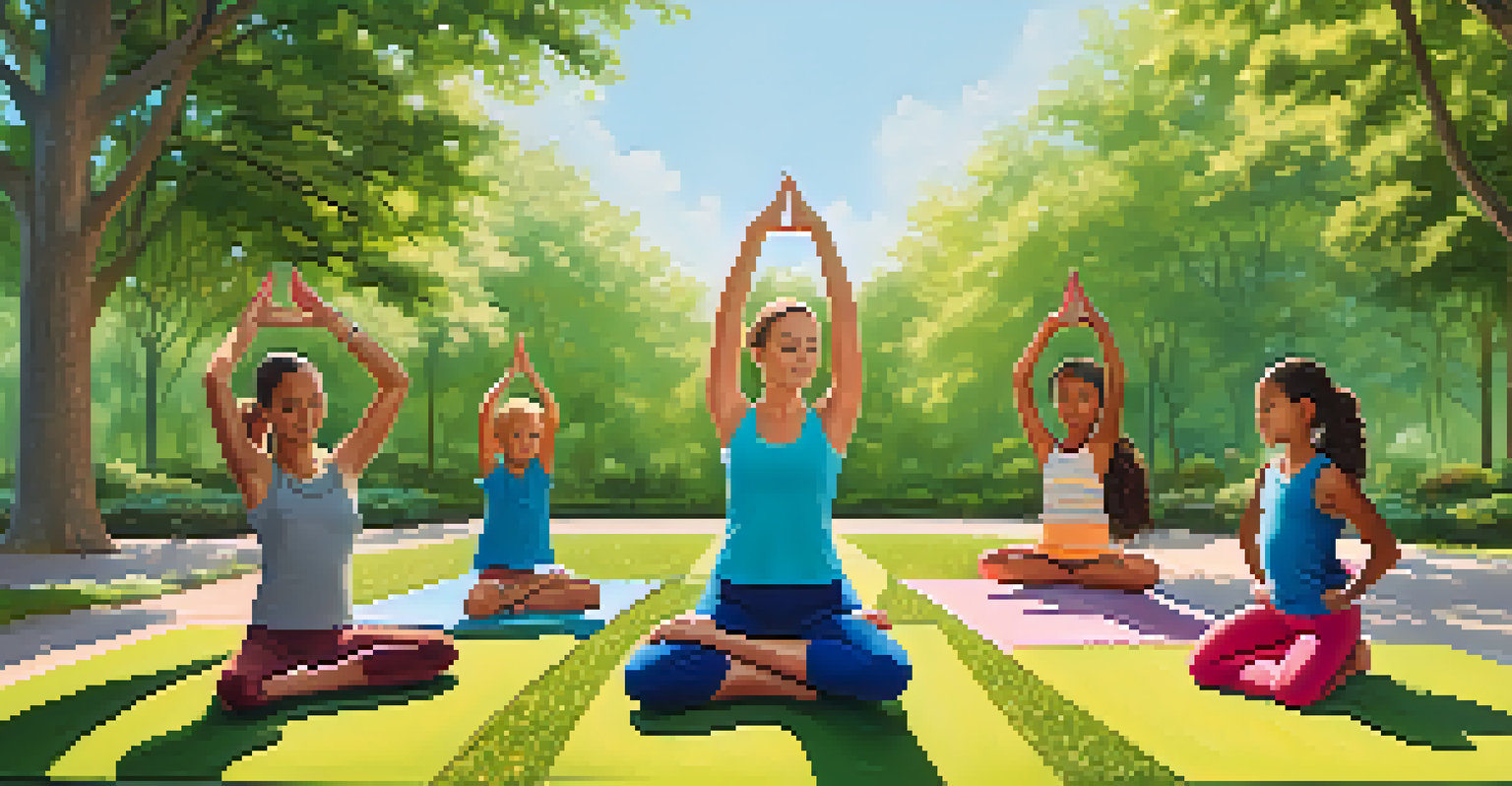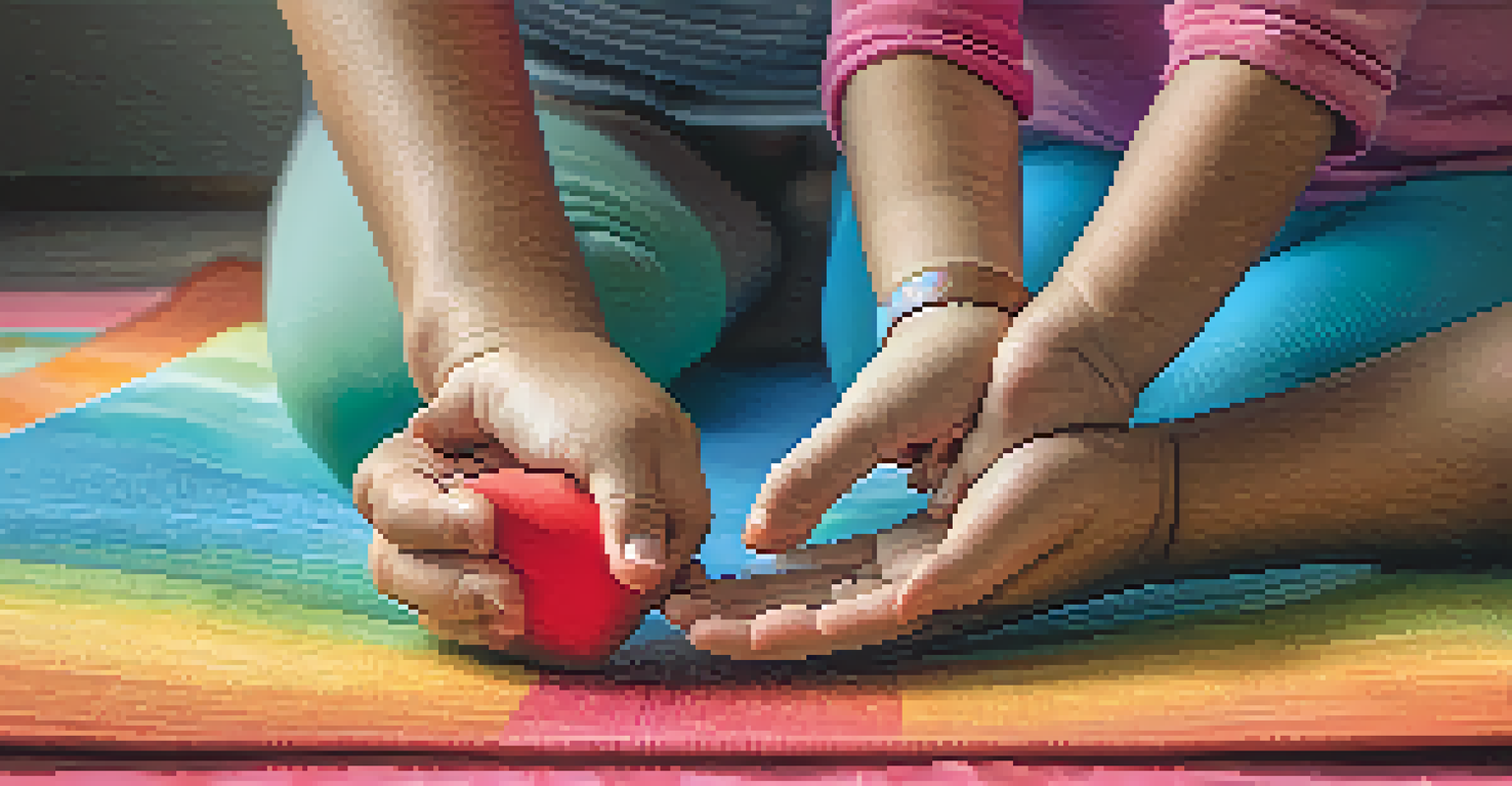How Family Yoga Promotes Communication and Cooperation

Introduction to Family Yoga and Its Benefits
Family yoga is a wonderful practice that brings family members together on the mat, fostering connection and mindfulness. Unlike traditional yoga, it emphasizes collaboration and interaction, making it an ideal activity for families. Through shared poses and breathing exercises, participants learn to communicate and cooperate in a fun and engaging way.
Yoga is the journey of the self, through the self, to the self.
One of the key benefits of family yoga is its ability to create a safe space for open dialogue. Families often lead busy lives, and finding moments to connect can be challenging. However, on the yoga mat, everyone is encouraged to share their thoughts and feelings, building trust and understanding among family members.
As families practice together, they not only strengthen their bodies but also their relationships. The shared experience of navigating poses and supporting one another fosters a sense of teamwork. This teamwork translates into better communication off the mat, as family members learn to express themselves more openly.
Building Trust Through Shared Experiences
Trust is the foundation of any healthy relationship, and family yoga helps build that trust through shared experiences. When families practice yoga together, they face challenges as a unit, whether it's holding a difficult pose or coordinating movements. This collective effort encourages families to rely on one another, reinforcing their bond.

For instance, consider a family attempting a partner pose. They must communicate effectively to maintain balance and support each other, which naturally cultivates trust. As they succeed or laugh through their attempts, they create memories that strengthen their connection.
Build Trust Through Shared Yoga
Family yoga fosters trust by encouraging families to face challenges together, enhancing their bond and communication.
In this way, family yoga becomes more than just a physical practice; it transforms into a journey of discovery. Each session reveals the strengths and weaknesses of individual family members, allowing for deeper understanding and empathy. This newfound trust enhances communication at home, making it easier to tackle challenges together.
Promoting Active Listening Skills
Active listening is a vital skill in any relationship, and family yoga can help hone this ability. During yoga sessions, family members often take turns guiding one another through poses, which requires focused listening to understand instructions. This practice encourages everyone to be present and engaged, fostering better communication habits.
The family is one of nature's masterpieces.
As family members practice active listening during yoga, they learn to apply it outside the studio as well. For example, when a child is sharing their day, parents who have practiced active listening on the mat may find themselves more attentive and responsive. This shift can lead to deeper conversations and a more open family dynamic.
Moreover, the mindfulness aspect of yoga enhances listening skills even further. By being mindful of their breath and body during practice, family members become more aware of their surroundings and their loved ones. This heightened awareness translates into stronger communication skills, enabling families to navigate discussions with greater ease.
Encouraging Non-Verbal Communication
Family yoga is not just about verbal communication; it also emphasizes non-verbal cues. Through poses and movements, families learn to express themselves without words, relying on body language and gestures. This aspect of yoga can be particularly beneficial for children, who may struggle to articulate their feelings verbally.
For example, a child may feel nervous or anxious about a situation but may not know how to express those feelings. During yoga, they can use their body to convey emotions, whether through a gentle stretch or a grounding pose. Parents can then respond to these cues, fostering an environment of understanding and support.
Enhance Active Listening Skills
Practicing yoga together improves active listening, which translates into more attentive and meaningful conversations at home.
In this way, family yoga teaches the importance of both verbal and non-verbal communication. By recognizing and responding to each other's body language, families develop a deeper connection. This holistic understanding of communication can lead to more meaningful interactions beyond the yoga mat.
Strengthening Problem-Solving Abilities
Yoga often presents challenges that require creative problem-solving, particularly in family settings. When families encounter a tricky pose, they must collaborate to find a solution, whether through adjusting body positions or providing support. This teamwork nurtures critical thinking and adaptability among family members.
For instance, if a family struggles with a particular pose, they might brainstorm alternatives or modify it to suit everyone's abilities. This process not only encourages cooperation but also helps family members feel valued and heard. Each individual's input contributes to the overall success of the group.
As families face these challenges together, they cultivate a sense of resilience. They learn that it's okay to stumble and that working together can lead to greater achievements. This newfound problem-solving ability can easily extend to everyday family situations, transforming the way they approach challenges.
Fostering Empathy and Compassion
Empathy and compassion are essential components of healthy relationships, and family yoga nurtures these qualities. As families practice together, they witness each other's struggles and triumphs, creating an environment of support and understanding. This shared journey fosters a sense of empathy that can deepen family bonds.
For example, when one family member faces difficulty with a pose, the others can offer encouragement and assistance. This act of compassion not only helps the individual but also strengthens the collective spirit of the family. Over time, these moments of support can lead to increased compassion in daily interactions.
Create Lasting Family Memories
Family yoga sessions generate joyful memories and traditions, strengthening family identity and connection over time.
By practicing empathy on the mat, families can carry these lessons into their everyday lives. They become more attuned to each other's feelings and needs, leading to more compassionate communication. This shift in perspective can transform family dynamics, creating a nurturing and loving environment.
Creating Lasting Family Memories
Family yoga is not just about physical practice; it's about creating lasting memories together. The laughter, challenges, and shared moments during sessions contribute to a family's unique story. These memories become the foundation of a strong family identity and shared experiences.
As families engage in yoga, they create a treasure trove of stories to share, whether it's the time they attempted a challenging pose or the fun they had during a playful session. These anecdotes not only bring joy but also remind family members of their journey together. They become cherished memories that strengthen their bond.

Moreover, as families continue practicing yoga together, they build a tradition that can be passed down through generations. This shared activity becomes a hallmark of their family identity, creating a legacy of communication and cooperation. In this way, family yoga transcends the mat, weaving itself into the fabric of family life.